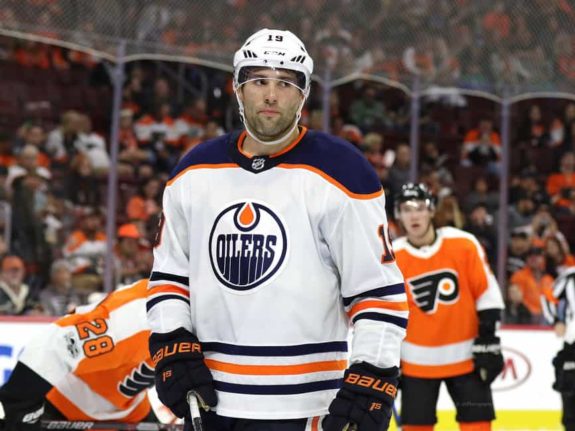Much had been made of Patrick Maroon’s chance to win a fourth straight Stanley Cup last year with the Tampa Bay Lightning. This year, the chatter revolves around his chance to advance to his fifth straight Cup Final. No matter what happens, there is no doubt that his presence on the team makes them a playoff contender.
Since Maroon’s arrival in Tampa, he has helped the team win two Stanley Cups and has become a beloved teammate and fan favorite. During his career, he has always played well on any line, but he found his place on the heavily-stacked Lightning team on the adequately named School Bus Line, along with Pierre-Edouard Bellemare and Corey Perry. The moniker does not reflect their age, as each player is in his middle to late 30s. But it reflects that they carry one another on the fourth line. As veteran players, this trio has tons of playoff experience, but only Maroon has three championship rings.
Maroon Is the Enforcer on the Team
Before Maroon joined the Lightning, the team was never really known for having a true enforcer on the ice, with short-lived residencies for Zenon Konopka or Enrico Ciccone, who are usually cited as the top fighters in the team’s 30-year history. Maroon’s ability to inspire his teammates by dropping his gloves at a pivotal point in a game makes his importance to the team invaluable. He is tough to play against as it is nearly impossible to intercept the puck from the power forward. He uses his 6-foot-3, 238-pound frame to turn his body away from defenders and hog the puck before smoothly passing it to Bellemare, Perry or shooting it past the opposing team’s goalie.
Related: Lightning Found Important Cap Savings With Bellemare
This style of play has made him a star on every team he’s played for. Drafted in 2007 by the Philadelphia Flyers as the 161st overall pick, Maroon spent his early career proving himself in the American Hockey League (AHL). The Anaheim Ducks traded for him, and he finally broke into the regular lineup, where he played with his future Lightning teammate, Perry. They helped the team advance to the postseason, where they lost to the Chicago Blackhawks in the conference finals in 2015.

After coming close to winning the Cup, Maroon was sent to the Edmonton Oilers at the trade deadline, where he found his offensive mojo, and the team found themselves in the postseason for the first time in nearly a decade. During the regular season, he scored 14 points in 16 games before hitting his career high of 42 points during the 2016-17 season. When he was traded to the New Jersey Devils on Feb. 26, 2018 (yup, you guessed it), they made the Stanley Cup Playoffs for the first time since 2012. He continued his offensive output by scoring 13 points in the remaining 17 games of the season.
Maroon Wins His First Stanley Cup
By the time Maroon won the Stanley Cup with his beloved St. Louis Blues in 2019, he was already a postseason veteran. Growing up in Oakville, Missouri, he probably couldn’t have imagined that he would score a last-minute, game-winning, double-overtime goal versus the Dallas Stars in Game 3 of the Western Conference Final, catapulting the team to the championship. However, success is fickle, and the team decided not to re-sign him after winning their one and only Cup.
Once he began playing for the Lightning, he became an effective power forward. While Perry makes life miserable for goalies, jamming up the crease and battling for pucks behind the net, Maroon makes an impact on the boards. His real talent is his work beyond the boards — sitting on the bench, trash talking his opponents. Twelve minutes have passed, lines have rotated several times, and he is still “chirping” at anyone who will listen. His game-day chatter is legendary. This past season, Maroon received a 10-minute penalty for trash talking with Toronto Maple Leafs’ Wayne Simmonds.
“This game is going the wrong way,” Maroon said, according to The Athletic’s Joe Smith. “I guess you can’t chirp each other on the bench now.”
Experiencing success with every team he has been on, what makes Maroon’s play so effective? For one thing, he gradually wears down his opponents by playing a bruising style of game. In other words, playing like Maroon likes to play, which is exactly what the Lightning were hoping for. Last season, he logged the most penalty minutes of his career at 134 in 81 games. He’s the type of player that other teams and fans love to hate. His play isn’t dirty, just annoying as he gets under the skin of the opposition. Another reason he is effective is he enjoys the game and interacting with the fans.

Although the Lightning have a ton of offensive weapons and effective defenseman, Maroon’s tough play, along with his veteran fourth liners, have made the Lightning a tough, gritty team. Tampa was not exactly known as a gritty team before they acquired Maroon, but he provided that spark that makes the team difficult to play against. He’s just doing what he does best — helping his team secure a playoff spot. Here’s hoping that he can get to that fifth straight Final this coming season.